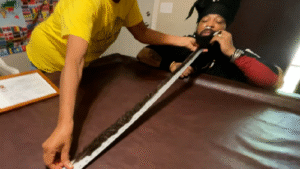- Moderates: Led by leaders like Gopal Krishna Gokhale and Dadabhai Naoroji, they believed in gradual reforms and using constitutional methods to achieve Indian self-rule.
- Extremists: Led by figures like Bal Gangadhar Tilak, Bipin Chandra Pal, and Lala Lajpat Rai, who advocated for more direct and confrontational methods, such as boycotts and the Swadeshi movement, to demand self-rule.
- The ideological differences between these two factions reached a breaking point, which culminated in the Surat session of 1907.
- The Surat session of the INC, held in Gujarat, witnessed violent disagreements between the Moderates and Extremists over the direction and methods of the party.
- The conflict escalated into physical altercations, forcing the session to be dissolved prematurely without any resolutions being passed.
- This event marked a formal split in the INC, with the two factions functioning separately for a few years:
- The Extremists continued their activism outside the Congress.
- The Moderates dominated the party until the reunification in 1916 at the Lucknow session.
- In the aftermath of the split, the Moderates retained control of the INC and realized the need for a formal framework to govern the party’s activities and structure.
- The first constitution of the INC was drafted and adopted in 1908 with the following objectives:
- To define the organizational structure and roles within the INC.
- To clarify the membership criteria and decision-making processes.
- To establish a more formal procedure for conducting sessions and resolving disputes.
- This constitution was primarily designed to consolidate the party under Moderate leadership and prevent future divisions.
- The adoption of the INC’s first constitution marked a step toward institutionalizing the organization, providing it with a robust structure and formal mechanisms for operation.
- However, the exclusion of the Extremists weakened the nationalist movement temporarily, as their activism and energy were crucial for mobilizing mass support.
- The split in the INC was healed in 1916 during the Lucknow session, facilitated by a mutual understanding between the Moderates and Extremists.
- This session also witnessed the historic Lucknow Pact between the INC and the All India Muslim League, signaling a united front in the struggle against British rule.
- The first constitution of the Indian National Congress was drafted in 1908, following the split between the Moderates and Extremists at the 1907 Surat session.
- This constitution formalized the party’s structure and processes but led to a temporary weakening of the nationalist movement due to the absence of the Extremists’ influence.
- The split was ultimately resolved in 1916 at the Lucknow session, which also marked the signing of the Lucknow Pact, uniting the INC and the Muslim League in their fight for independence.







